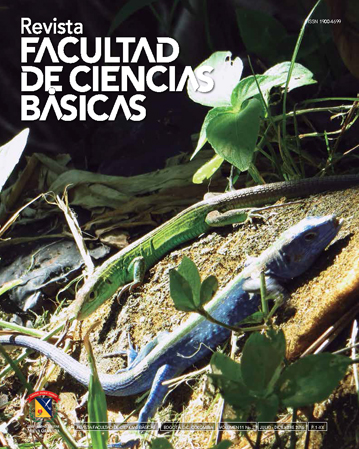Alteraciones Histopatológicas de los Bulbos Olfatorios de Cachama Blanca ante una Presentación Comercial de Glifosato: (Roundup® Activo)
Resumen
El glifosato, en su presentación comercial Roundup® Activo, es un herbicida de amplio uso en Colombia. Se ha reportado que en Piaractus brachypomus este herbicida puede generar alteraciones a nivel cerebral incluyendo los bulbos olfatorios y se plantea que una de sus posibles vías de entrada al sistema nervioso central es el sistema olfativo. Por tal motivo, se pretende determinar las alteraciones histopatológicas del Roundup® Activo en los bulbos olfatorios de P. brachypomus. Se utilizaron 45 alevinos de P. brachypomus tratados con tres dosis (0, 0.1 y 1 mg/l) de Roundup® Activo durante un mes. Trascurrido un mes los cerebros fueron disectados, fijados y procesados para procesamiento en microscopia óptica de alta resolución. El tratamiento de 0 mg/l de Roundup® Activo no presentó alteraciones histopatológicas en las diferentes células de los núcleos neuronales se observaron normales. No obstante, los individuos expuestos a 0.1 y 1 mg/l de Roundup® Activo presentaron células granulares que se identificaron principalmente asociadas a los vasos sanguíneos de la pía madre del bulbo olfativo. La presencia de células granulares en los bulbos olfatorios es un indicativo de daños a nivel tisular. Teniendo en cuenta que el sistema olfativo está directamente implicado procesos vitales para los peces como la alimentación, la reproducción y el reconocimiento intra e inter específico; exposiciones prolongadas a este herbicida podrían afectar el adecuado desarrollo de P. brachypomus y su interacción con el ambiente.Descargas
Lenguajes:
esAgencias de apoyo:
Universidad Militar Nueva GranadaReferencias bibliográficas
Achiorno CL, Villalobos C, Ferrari L. 2008.Toxicity of the herbicide glyphosate to Chordodes nobilii (Gordiida, Nematomorpha). Chemosphere, 71: 1816–1822.
Agudelo C, Pineda Z, Acosta S, Ramírez G, Ajiaco M, Gonzales C. 2011. Piaractus brachypomum (Cuvier 1818). p. 236-242. En: Lasso A, Agudelo C, Jimenez S, Ramirez G, Morales B, Ajiaco M, Gutierrez F, Usma O, Muñoz , Sanabria O. 2011. Catalogo de recursos pesqueros continentales en Colombia. Serie editorial recursos hidrobiológicos y pesqueros continentales de Colombia. Instituto de investigaciones de los recursos biológicos Alexander von Humboldt. Bogotá, Colombia.
Bretaud S, Toutant JP, Saglio P. 2000. Effects of carbofuran, diuron and nicosulfuron on acetylcholinesterase activity in goldfish (Carassius auratus). Ecotoxicol. Environental, 47: 117–124.
Caldas ML, Hurtado H, Barrera B. 2008. Estudio histológico y morfológico preliminar de la hipófisis de alevinos de cachama blanca Piaractus brachypomus, (Characidae: Piaractus). Actualidades Biológicas, 30 (89): 100-110
Caldas ML, Ricaurte O, Rodríguez G, Amaya J. 1993. Microscopía óptica de alta resolución “MOAR”. Instituto Nacional de Salud. Bogotá, Colombia.
Cammarata M, Vazzana M, Cervello M, Arizza V, Parrinello N. 2000. Spontaneous cytotoxic activity of eosinophilic granule cells separated from the normal peritoneal cavity of Dicentrarchus labrax. Fish Shellfish Immunol, 10:143-54
CCAC. Canadian Council on Animal Care. 2005. Guidelines on: the care and use offish in research, teaching and testing. Ottawa, Ontario, Canada: Canadian Council on Animal Care.
Dezfuli BS, Giari L, Simoni E, Palazzi D, Manera M. 2003. Alteration of rodlet cells in chub caused by herbicide Stam® M-4 (Propanil). J Fish Biol;63:232–9.
Dezfuli BS, Giovinazzo G, Lui A, Giari L. 2008. Inflammatory response to Dentitruncus truttae (Acanthocephala) in the intestine of brown trout. Fish Shellfish Immunol, 24:726–33.
Dezfuli BS, Pironi F, Giari L, Noga EJ. 2010. Immunocytochemical localization of piscidin in mast cells of infected seabass gill. Fish & Shellfish Immunology 28: 476-482
Dinehart SK, Smith LM, McMurry ST, Smith PN, Anderson TA, Haukos DA. 2010. Acute and chronic toxicity of Roundup Weathermax and Ignite 280 SL to larval Spea multiplicata and S. bombifrons from the Southern High Plains, USA. Environ Pollut,158(8): 2610-7.
Eslava-Mocha PR, Ramirez-Duarte WF, Rondon-Barragan IS. 2007. Sobre los efectos del glifosato y sus mezclas: Impacto sobre peces nativos. Universidad de los Llanos. Colombia, 150 p.
Evrard E, Marchand J, Theron M, Pichanvant-Rafini K, Durand G, Quiniou L, Laroche J. 2010. Impacts of mistures of herbicides on molecular an physiological responses of the European flounder Platichthys flesu. International journal Comparative Biochemistry and Physiology, 152(3): 321-31.
Flaño E, Lopez-Fierro P, Rasquin BE, Villena A. 1996. In vitro differentiation of eosinophilic granular cells in Renibacterium salmoninarum-infected gill cultures from rainbow trout. Fish & Shellfish Immunology 6:173-84.
Galli SJ. Biology of disease. 1990. New insights into ‘‘The riddle of the mast cells’’: microenvironmental regulation of mast cell development and phenotypic heterogeneity;62:5-33.
Glusczak L, Santos DM, Crestani M, Fonseca MB, Araujo FP, Frescura MD, Pimentel V L. 2006. Effect of glyphosate herbicide on acetylcholinesterase activity and metabolic and hematological parameters in piava (Leporinus obtusidens). Ecotoxicology and Environmental Safety, 65: 237–241.
Glusczak L, Santos DM, Silveira MB, Rodrigues RS, Chitolina MRS, Morsch VM, Loro VL. 2007. Acute effects of glyphosate herbicide on metabolic and enzymatic parameters of silver catfish (Rhamdia quelen) Comparative Biochemistry and Physiology, Part C 146: 519–524.
Hamdani EH, Døving KB. 2007. The functional organization of the fish olfactory system. Progress in Neurobiology, 82: 80–86.
Jaramillo J, Gómez E, Caldas ML, Rodríguez D, Hurtado H. 2009. Histology and morphometry of dorsal root ganglia and their neurons in a fish of indeterminate growth the white cachama (Piaractus brachypomus). Actualidades Biológicas, 31: 43-52.
Keith B. Tierney, David H. Baldwin, Toshiaki J. Hara, Peter S. Ross, Nathaniel L. Scholz, Christopher J. Kennedy. 2010. Olfactory toxicity in fishes. Aquatic Toxicology, 96: 2–26.
Kirshenbaum AS, Kessler SW, Goff JP, Metcalfe DD. 1991. Demonstration of the origin of human mast cells from CD34Cbone marrow progenitor cells. Journal of Immunology;146:1410-5.
Kolpin D, Thurman M, Lee E, Meyer M, Furlong E, Glassmeyer S. 2006. Urban contributions of gliphosate and its degradate AMPA to streams in the United States. Journal Science of the total environment, 354: 191-197.
Lushchak O, Kubrak O, Storey J, Storey K, Lushchak VI. 2009. Low toxic herbicide Roundup induces mild oxidative stress in goldfish tissues. International Journal Chemosphere, 76: 932-937.
Modesto KA, Martinez CBR. 2010. Roundup® causes oxidative stress in liver and inhibits acetylcholinesterase in muscle and brain of the fish Prochilodus lineatus. Chemosphere, 78:294–299.
Muñoz A, Caldas ML, Hurtado H. 2006. Análisis histomorfométrico del sistema digestivo y glándulas anexas de alevino de cachama blanca. Revista Facultad De Ciencias Básicas, 2 (1): 33-45.
Nivia E. 2001. Conferencia: Las Guerras en Colombia: Drogas, Armas y Petróleo” “The Wars in Colombia: Drugs, Guns and Oil” Instituto Hemisférico de las Américas Universidad de California, Davis, Mayo 17-19, 2001 Las fumigaciones aéreas sobre cultivos ilícitos si son peligrosas – Algunas aproximaciones.
Noga EJ, Silphaduang U. 2003. Piscidins: a novel family of peptide antibiotics from fish. Drug News Perspect 16:87-92.
Oldham J, Massey R, Cryan P. 2002. Aerial spraying in Colombia: and environmental effects. The Institute for Science & Interdisciplinary Studies (Fact Sheet) 4p.
Pineda SH, Olivera AM, Urcuqui IS, Builes GJ, Trujillo BE. 2004. Polimorfismo genético en cachama blanca Piaractus brachypomus (Characidae, Serrasalminae) mantenida en cautiverio. II Congreso Colombiano de Acuicultura. Villavicencio. p. 49-50.
Powell MD, Wright GM, Burka JF. 1990. Eosinophilic granule cells in the gills of rainbow trout, Oncorhynchus mykiss: evidence of migration? J Fish Biol;37:495-7.
Ramírez-Duarte WF, Rondón-Barragán IS, Eslava-Mocha PR. 2008. Acute toxicity and histopathological alterations of Roundup® herbicide on “cachama blanca” (Piaractus brachypomus). Pesq. Vet. Bras, 28 (11): 547-554.
Ramirez-Duarte WF, Rondon-Barragan IS, Vidal Barrios HH, Eslava-Mocha PR. 2004. Efectos del glifosato (GP) con énfasis en organismos acuáticos. Orinoquia, 7 (1-2): 70-100.
Reite OB, Evensen O. 2006. Inflammatory cells of teleostean fish: A review focusing on mast cells/eosinophilic granule cells and rodlet cells. Fish & Shellfish Immunology, 20(2): 192-208.
Reite OB. 1997. Mast cells/eosinophilic granule cells of salmonids: staining properties and responses to noxious agents. Fish & Shellfish Immunology, 7:567-84.
Rondón-Barragán IS, Ramírez-Duarte WF, Eslava-Mocha PE. 2007. Evaluación de los efectos tóxicos y concentración letal 50 del surfactante Cosmoflux® 411F sobre juveniles de cachama blanca (Piaractus brachypomus). Rev Col Cienc Pec, 20: 431 – 446.
Schmale MC, Vicha D, Cacal SM. 2004. Degranulation of eosinophilic granule cells in neurofibromas and gastrointestinal tract in the bicolor damselfish. Fish Shellfish Immunol, 17:53–63.
Silphaduang U, Noga E. 2001. Peptide antibiotics in mast cells of fish. Nature;414:268-9.
Soso AB, Gil Barcellos LJ, Ranzani-Paiva MJ, Kreutz LC, Quevedo RM, Anziliero D, Lim M, Bolognesi da Silva L, Ritter F, Calliari Bedin A, Finco JA. 2007. Chronic exposure to sub-lethal concentration of a glyphosate-based herbicide alters hormone profiles and affects reproduction of female Jundiá (Rhamdia quelen). Environmental Toxicology and Pharmacology, 23: 308–313.
Tsui TK, Chu LM. 2003. Aquatic toxicity of glyphosate-based formulations: comparison between different organisms and the effects of environmental factors. Chemosphere, 52: 1189–1197.
Wilhelm M, Silver R, Silverman AJ. Central nervous system neurons acquire mast cell products via transgranulation. Eur J Neurosci 2005; 22:2238-2248.












